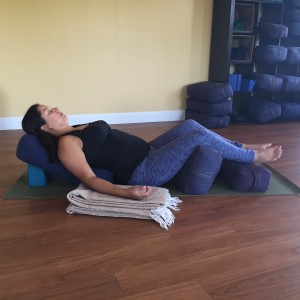Savasana: Are You Doing it Right?
If you’ve ever wondered whether you’re relaxing “correctly” in the final relaxation posture (aka śavāsana) in yoga class, this post is for you!
Śavāsana (shah-VAH-sah-nah), which translates as Corpse Posture, is the relaxation posture typically used at the end of the yoga āsana (AH-sah-nah) practice. It can also be used as a resting posture any time throughout āsana practice.
In this posture, the body lies supine (face up) with the arms and legs relaxed and positioned slightly out toward the sides. Palms typically face up. The neck should be in a neutral position, so for people who have a lot of tightness in their neck and/or shoulders, it may be necessary to use a small prop behind the head, such as a folded blanket or small pillow.
That said, there are many, many variations for śavāsana.
There are variations in purpose (Why are we doing this śavāsana? What do we hope to achieve?).
There are variations in method (How do we want to accomplish the goal of this śavāsana?).
There are variations is body positioning (Should we lie flat? Use props? Lie still? Change position?).
So if you’ve ever wondered whether you’re relaxing “correctly,” the answer is, “It depends!”
Purposes of Śavāsana
There are three main purposes of Śavāsana.
The first is to establish a sense of deep relaxation, which is great for people who are very stressed, ill, or who are recovering from illness or injury.
The second is to allow the body time to rest and regain homeostasis (resting heart rate, resting rate of respiration) after performing vigorous āsana postures or sequences.
The third is to practice focusing the mind, which is beneficial for all people.
Śavāsana for Deep Relaxation
If the goal of Śavāsana is deep relaxation, the teacher may do a guided relaxation practice. In this case, you’ll be lying still for at least 10 minutes, so you’ll want to position your body in a very comfortable way.
For example, you might consider lining your mat with a layer of folded blanket for more padding. You might like to elevate your legs with a bolster (or two) behind your knees or lower legs. You might even build a recliner with a block and a bolster. The possibilities are endless. Try one of more of these suggestions, or ask your teacher for personalized guidance in creating a relaxation posture that suits your needs or goals.
Once you’re in a comfortable position, the teacher will begin a slow-paced set of instructions for systematically relaxing the body. You’ll just lie still, breathe naturally, listen to the instructions, and follow along. You can close your eyes to block out visual distraction if that feels comfortable for you.
The relaxation instructions are sometimes referred to as Yoga Nidra (NIH-drah). Nidra translates as Sleep, but the goal of relaxation is not necessarily to fall sleep. (Unless you are practicing Yoga Nidra for insomnia, in which case it would be ok to relax and fall sleep. See? Like I said, It depends!)
During deep relaxation, it’s common to feel as if you’re falling asleep, or you may actually drift in and out of sleep, especially if you’re sleep deprived. You might even hear one of your classmates quietly snoring.
Nevertheless, do try to stay awake and aware of the teacher’s instructions. Allow your body and mind to deeply relax. If you do end up falling asleep, don’t stress about it, just try again next time!
Śavāsana for Resting
This type of śavāsana gained new meaning for me during my January training in India. Theidea is to rest intermittently throughout the āsana practice, pretty much any time your breathing becomes labored.
I found this practice fascinating for a number of reasons.
First, it helps the practitioner become more self-aware by noticing the inner workings of your body. You learn to notice your deeper, harder breathing. You learn to feel when your heart is working harder.
When your body experiences strain, stop and lie down for a minute or two to take a relaxation break.
This type of śavāsana is an important differentiator between yoga and exercise. In exercise, we intentionally raise our heart rate for cardiovascular health and perhaps weight loss. In yoga, we’re using the body to teach the mind to focus. This Rest Śavāsana is a perfect example of how we use the body to train the mind.
This Rest Śavāsana is a great life lesson too. Rather than “stressing out,” “pulling an all-nighter,” “needing coffee, stat!”, “shopping till we drop,” “working hard and playing hard,” and “no pain, no gain,” we train ourselves to rest once in a while. It’s a great habit to help manage our stress levels and improve our overall health.
Śavāsana for Mental Focus
From the śavāsana posture, one can perform most any kind of breathing practice, the purpose of which one would think is to improve the breathing, but perhaps more importantly, is to train the mind to focus on something subtle (breathing).
The breathing practice can be done on its own, before or after a Relaxation Śavāsana, or during or after a Rest Śavāsana.
Depending on a number of factors, the teacher might cue you to focus on some aspect of the breathing, such as how it feels, counting the duration of the breath, coordinating a simple movement with the breath, or even mentally chanting a mantra on the exhales.
These different types of focus are designed to help you train your brain, improve your ability to quiet your mind, and focus on only one thing at a time.
So now you see how the śavāsana posture is very versatile and can be used in a variety of applications. There isn’t really a “right” or “wrong” way to practice, there’s just different ways to practice.
Do you have a question about yoga you’d like me to answer? Email it to me and I’ll be happy to answer in a future newsletter.
Have a great week!
All my best,
Zelinda
P.S. If you found this post useful, please share it!
Does Yoga Makes You Feel Guilty and Naughty?
I had a private lesson yesterday with two lovely women, friends who have had the good fortune of being workout buddies for a long time. They have a fun sense of humor and they’re used to working out hard with their trainer, which of course is awesome and so great for their health. They came to us for a private lesson with a couple of goals in mind: 1. To find out if they like yoga, and 2. To learn enough that they could transition into regular yoga classes.
These two ladies breezed through the first 45 minutes of the practice. We worked on chest openers, hip openers, strengthening, and balance. The physical part of the practice was a piece of cake for them, since they are so adept at using their bodies.
But when we transitioned to the relaxation part of the practice, something changed. Relaxation is something these two great ladies don’t typically practice, and it took a conscious shift in their mindsets to help them get comfortable with the idea of doing nothing.
One woman joked that she felt “guilty and naughty, like [she] should be doing chores at home.” And they laughed about not telling their trainer about this relaxation experience, because she might make them work harder in their next workout. It was all in fun, of course, but it spoke to a deeper truth in our society: Learning to relax is hard work.
This theme has come up consistently with the students in my lessons and classes lately. As a society, we are skilled at working hard, but we’ve never learned to relax. We perceive value in hard work and we equate relaxation with laziness. But the fact of the matter is that we need balance. Just like how in our asana practice we strive to balance effort and ease, so must we do in our lives.
If we spend our lives in a cycle of hard work and stress, we run the risk of poor health, a short life, or sadly, both.
 But the good news is that relaxation practices can help undo some of the harmful effects of stress. Some of our regular, long-term students have managed their stress and improved their health so much that their doctors have reduced or even eliminated their blood pressure or diabetes medication. There are real benefits to learning how to relax.
But the good news is that relaxation practices can help undo some of the harmful effects of stress. Some of our regular, long-term students have managed their stress and improved their health so much that their doctors have reduced or even eliminated their blood pressure or diabetes medication. There are real benefits to learning how to relax.
And please know that knowing how to relax is not inherent to us as humans. It needs to be practiced and learned. I teach yoga for a living, and even I struggle with relaxation sometimes.
Just this morning, I had a very stressful time getting out the door with my kids. I dropped them off at their summer camp and as I was driving back home I was thinking about the long list of things I need to do today. It was a real challenge for me decide to pull into the studio so I could have a few minutes to move, breathe, relax, and reset, before beginning my work today.
But here’s the thing. We must take care of ourselves first, or we eventually wear ourselves out and can’t do a great job at anything.
For example, when I’m too tired and stressed, I’m a distracted and short tempered mom, a less present and less beneficial Yoga teacher, and an unfocused and inefficient business person.
From a productivity perspective, it’s so worthwhile to consistently practice relaxation and create an element of ease in your life, especially for busy people. Because when your mind is at ease you are more focused, more creative, and your mind is sharp. You can get more done. And ultimately, who doesn’t want that?
So even if it seems next to impossible, please try to build some relaxation into your life. Make time for a hot bath in the tub (Epsom salt rocks!), or go to bed early, or wake up early so you have a few minutes to practice breathing before you start your day.
Or come in and see us. We have all sorts of ways to teach relaxation. You can choose from private lessons or yoga classes, or we have a meditation workshop coming up on Saturday, or if you’re brand new you might want to try a Beginners Series.
Browse around our website to find something that feels like the right fit for you right now. And if you’re not sure where to start, or if the idea of relaxing sounds intimidating, just send me a note. I’ll be honored to help.

XO, Zelinda

